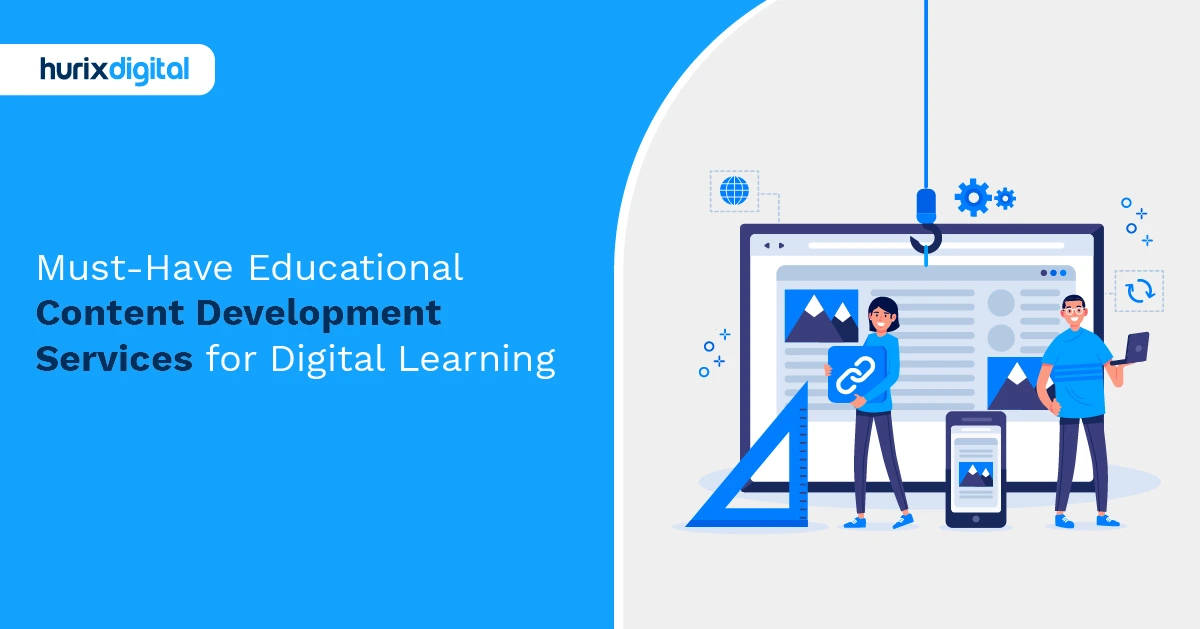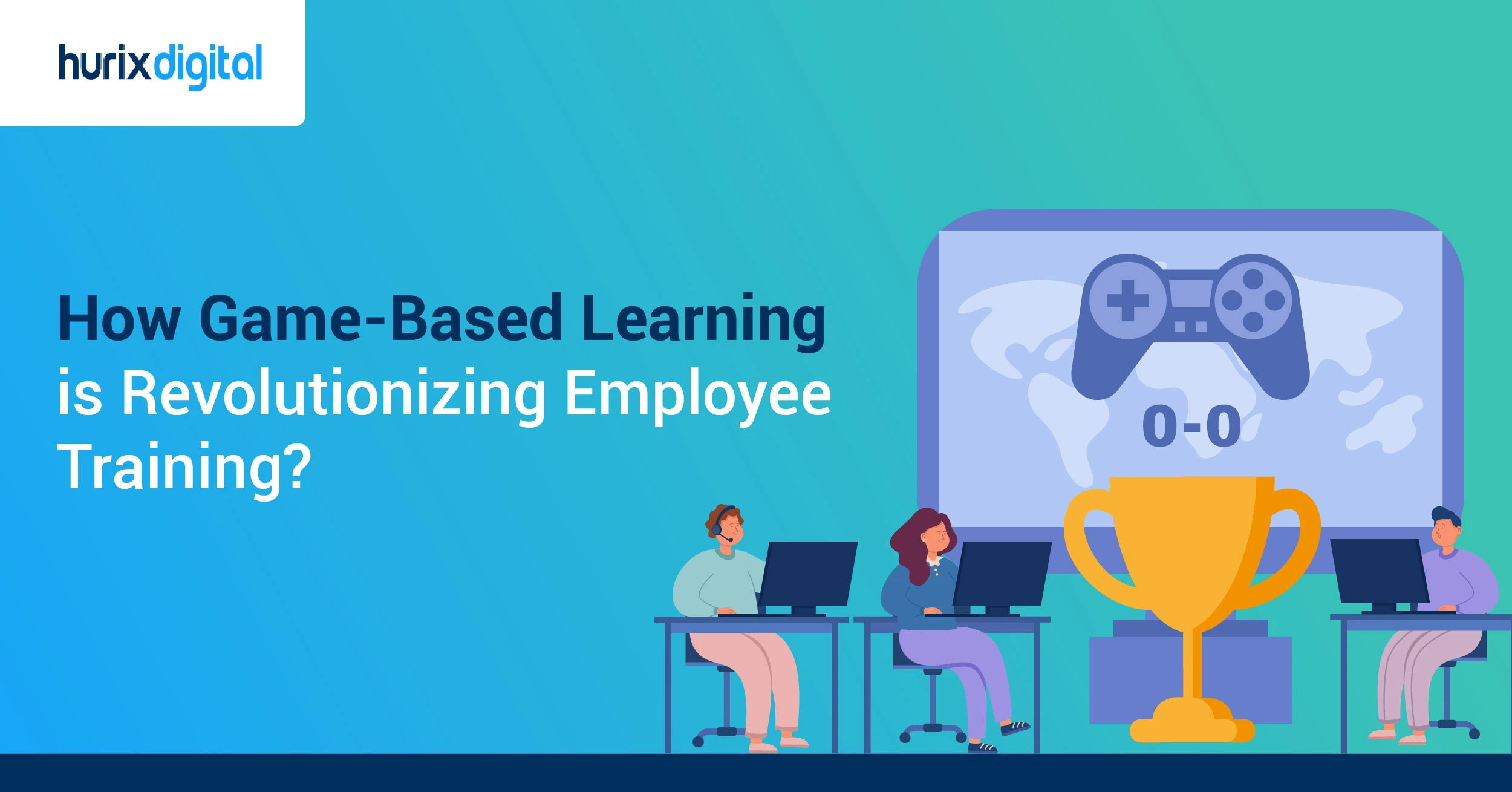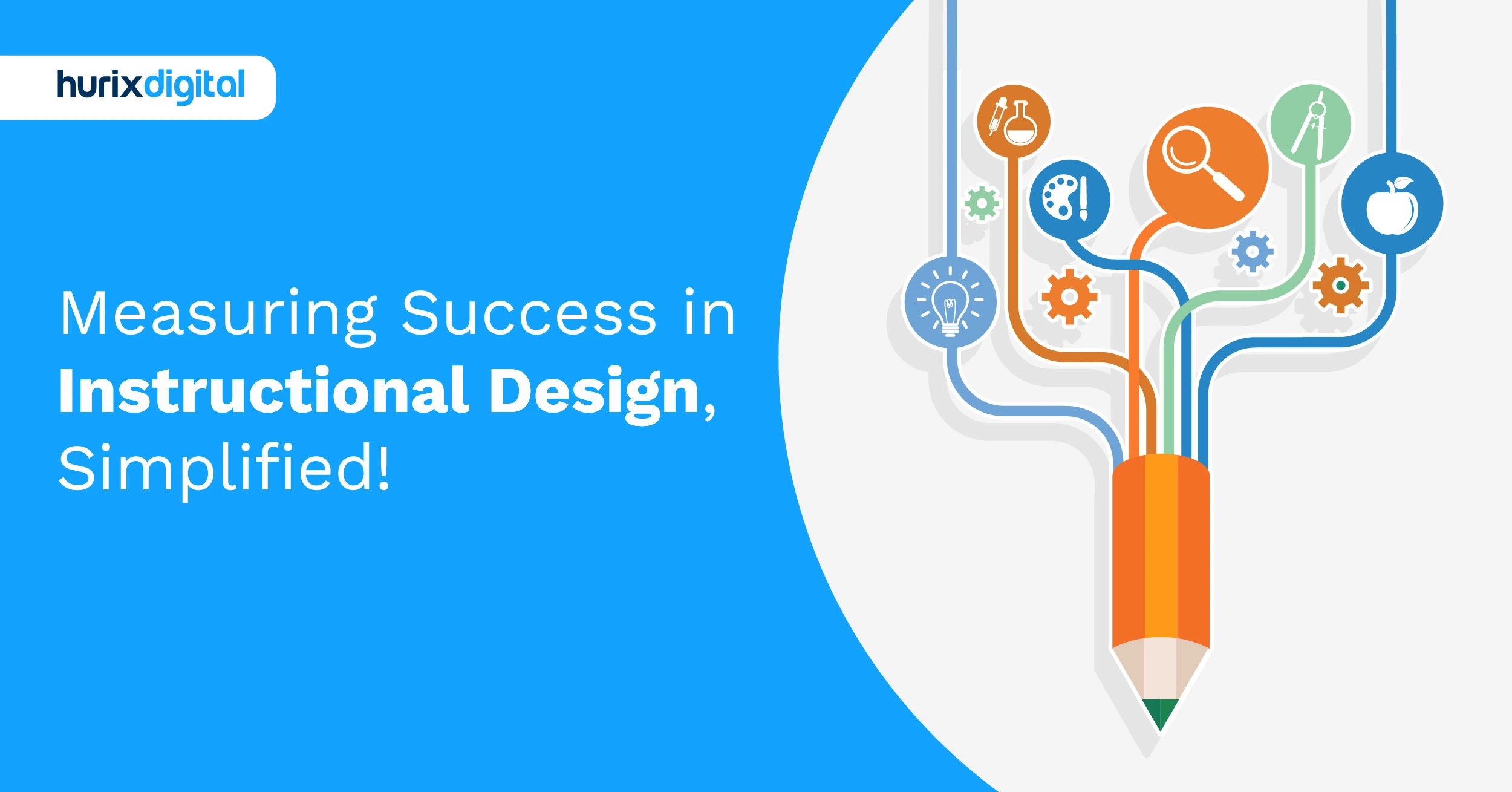
Measuring Success in Instructional Design, Simplified!
Summarize with:
Modern corporate businesses need employee development, instructional design, and enterprise learning investments to stay competitive in their markets. Corporate learning services demonstrate substantial power because they provide double benefits to employees and their organizations over the long term.
The primary element of this financial commitment involves knowing how instructional design affects return on investment (ROI). Organizations use this metric to determine the success and cost-efficiency of their training programs.
This article discusses instructional design and how you can measure your success.
Table of Contents:
- What is the ROI of Instructional Design?
- Why is the ROI of Instructional Design So Important in Workforce Learning?
- Why Assess and Evaluate Learning Outcomes?
- What are the Types of Assessment?
- Planning Assessment In Instructional Design
- 7 Methods of Instructional Design ROI Measurement
- Indicators that Your Instruction Needs Improvement
- Summing Up
What is the ROI of Instructional Design?
The ROI of instructional design is a metric used to evaluate the effectiveness and efficiency of training programs. It quantifies the benefits gained from these programs about the costs incurred. It answers the question: “Is the investment in instructional design providing a worthwhile return?” Ideally, the ROI for your firm is based on the success of learning and retention, which are nuanced aspects that almost elude measurement and cannot be equated with a learner signing off on completion.
Why is the ROI of Instructional Design So Important in Workforce Learning?
The ROI of instructional design is important as it helps assess the effectiveness of the training materials. Creating educational materials that align with the enterprise’s needs can produce a positive ROI. In all this, it would help to bear in mind that employee training is a long-term investment. It is important to approach training as a long-term investment as not all training will yield immediate results, such as an increase in your bottom line. While some training will show up almost immediately in terms of costs and revenues, employee training, by and large, is about building a foundation for progress and growth. It will yield significant financial returns but over a longer period. Let us examine the main reasons ROI is important in workforce learning.
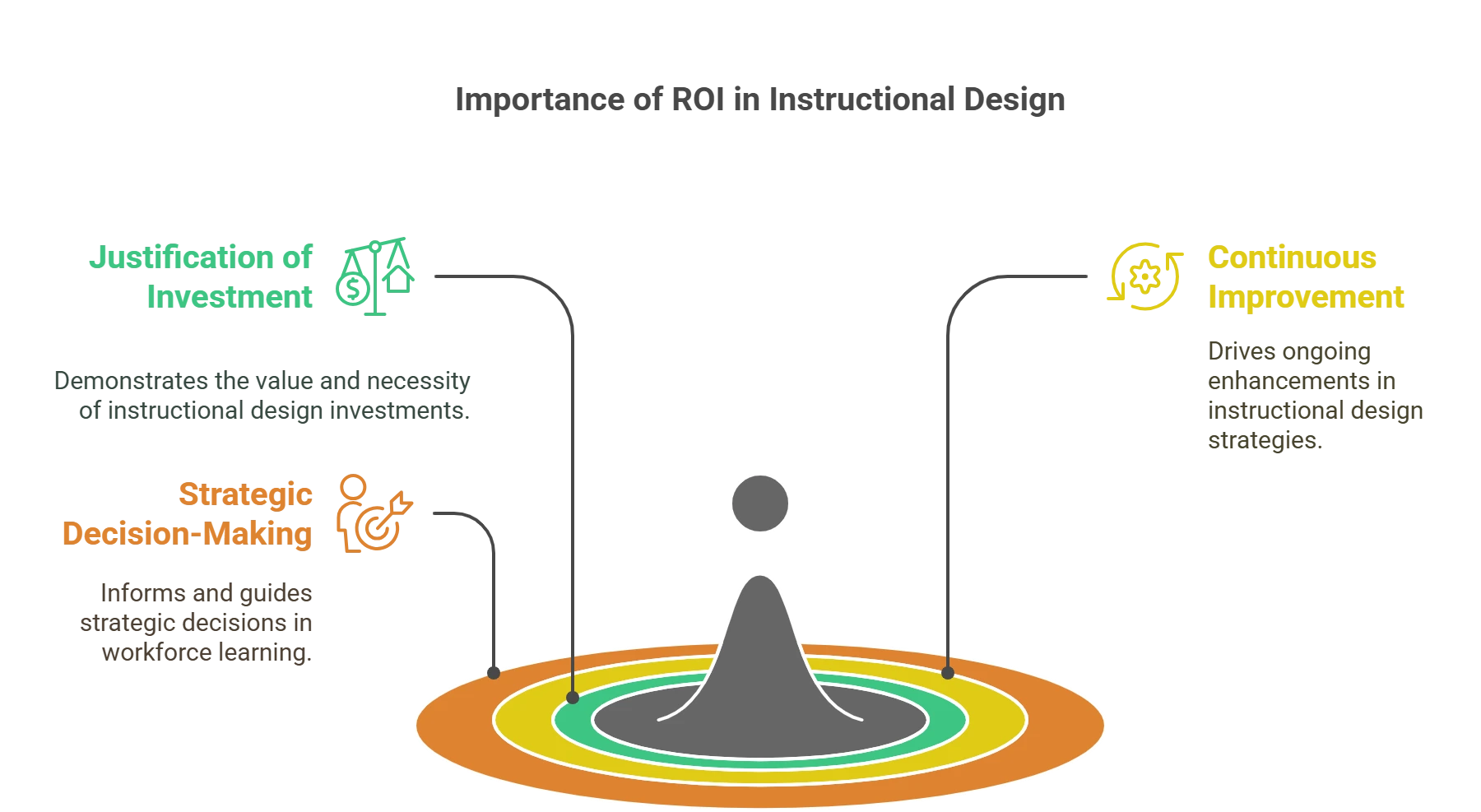
- Justification of Investment: Demonstrating a positive ROI assures stakeholders that resources are being utilized efficiently for employee development. An inspiring and effective ID will impact business metrics such as sales, productivity, operating costs, employee job engagement, employee retention, job promotion, and other targeted measures. So, the pertinent question is: Do the monetary benefits of the increase in business impact outweigh the costs of the plan and design of the instructional program? If yes, then the investment is justified.
- Continuous Improvement: Measuring the return on investment in training programs provides insights into what works and what doesn’t, allowing for refinement and enhancement of training programs. It helps identify challenges and weak areas in the program and enables course correction earlier than later.
- Strategic Decision-Making: It empowers decision-makers to allocate resources effectively, focusing on initiatives that yield the highest ROI. The cost-effectiveness of instructional design goes a long way toward ensuring a positive ROI.
Why Assess and Evaluate Learning Outcomes?
Assessment and evaluation enable you to confirm that the instruction is designed to achieve the planned learning outcomes. It helps determine:
- Whether instructional goals are in line with the program requirements
- Whether lesson plans, learning materials, and assessments are integrated with specific learning needs
- Whether any changes need to be made to the instruction to make it more effective
- Whether the execution of the learning design provides satisfactory instruction, helps achieve the instructional objectives, and helps learners obtain the requisite skills and knowledge
- Whether it equips learners to transfer their learning into applied skills and relevant contexts
Outcome-based assessment is a key component of evaluating programs, which focuses on student learning outcomes and the impact of learning. Learning outcomes assessment can help you understand a course’s strengths and possible drawbacks and determine areas of improvement.
What are the Types of Assessment?
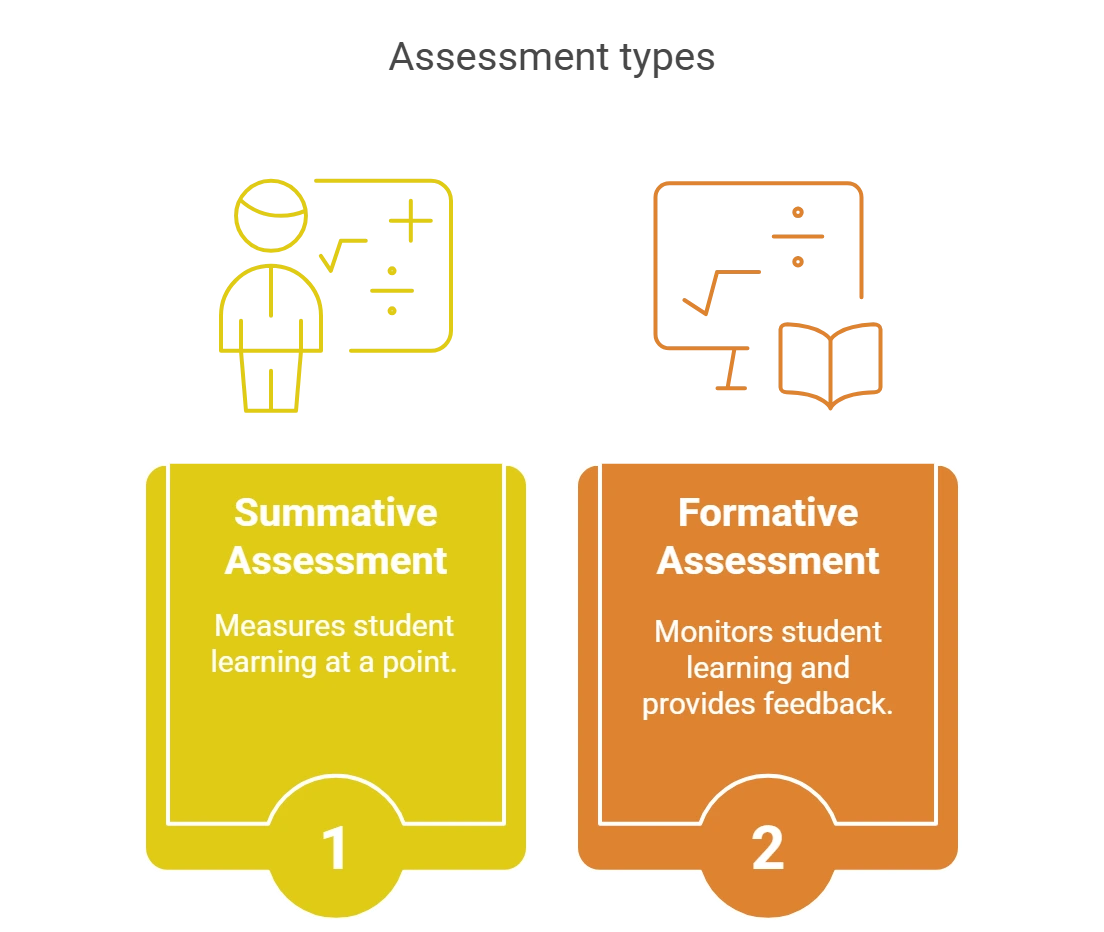
There are two main types of assessment. These are as follows:
1. Summative Assessment
This includes tests, quizzes, and other graded assessments that measure student performance. Performance evaluations are usually conducted at the end of the course or module and display what the participants have learned.
2. Formative Assessment
This usually takes place on an ongoing basis through the learning process. Students receive input, guidance, and feedback on their performance that can enable them to improve.
This can be done face-to-face or through comments on assignments, rubrics, emails, and other ways of giving feedback.
Planning Assessment In Instructional Design
Assessment is more successful if it is defined in a plan – whether you are assessing course learning or the whole curriculum. Here are some of the key steps in coming up with an assessment plan.
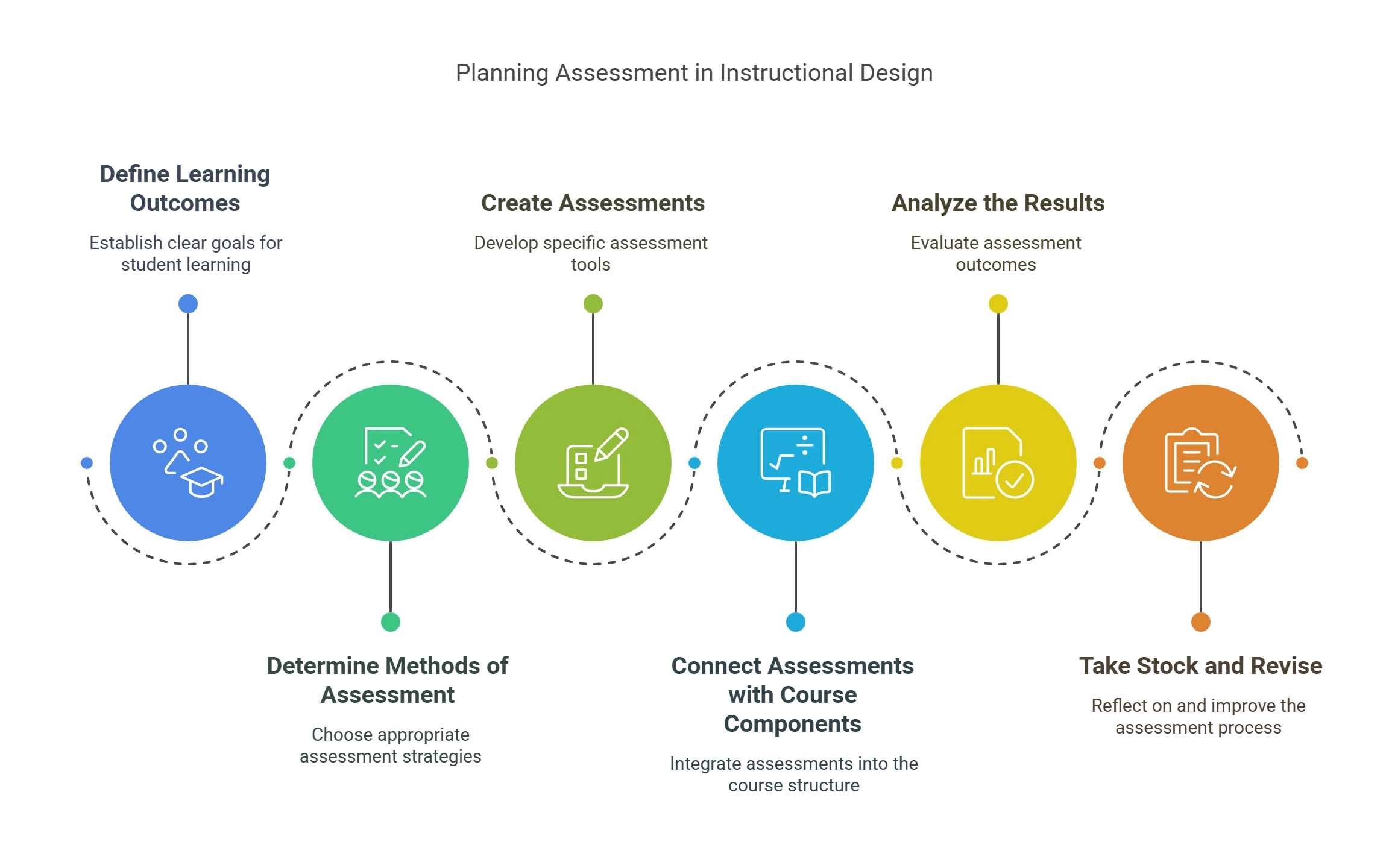
1. Define Learning Outcomes
The first step in developing assessment strategies is to set the learning objectives.
2. Determine Methods of Assessment
As an instructor, you must decide how you will determine that students meet the learning outcomes through assignments or other assessment forms.
3. Create Assessments
Create formats and performance criteria for assessments.
4. Connect Assessments with Other Components of the Course
The main assessment forms can be integrated with smaller assignments and ongoing learning such as lectures, discussions, and other activities.
5. Analyze the Results
This involves reading and scoring assignments and comparing them to set performance objectives.
6. Take Stock and Revise
After the assessment, instructors can develop learning and assessment plans for the rest of the course based on the areas of strength and improvement identified through the assessment and evaluation.
7 Methods of Instructional Design ROI Measurement
Measuring ROI in learning and development is complicated, to say the least. When it comes to training, for instance, determining the value of an investment isn’t as clear as measuring the value-add of new manufacturing equipment meant to expedite production. The gains in employee competency and efficiency are less concrete, albeit measurable. For example, training employees to use a new software could have variable productivity gains across your workforce.
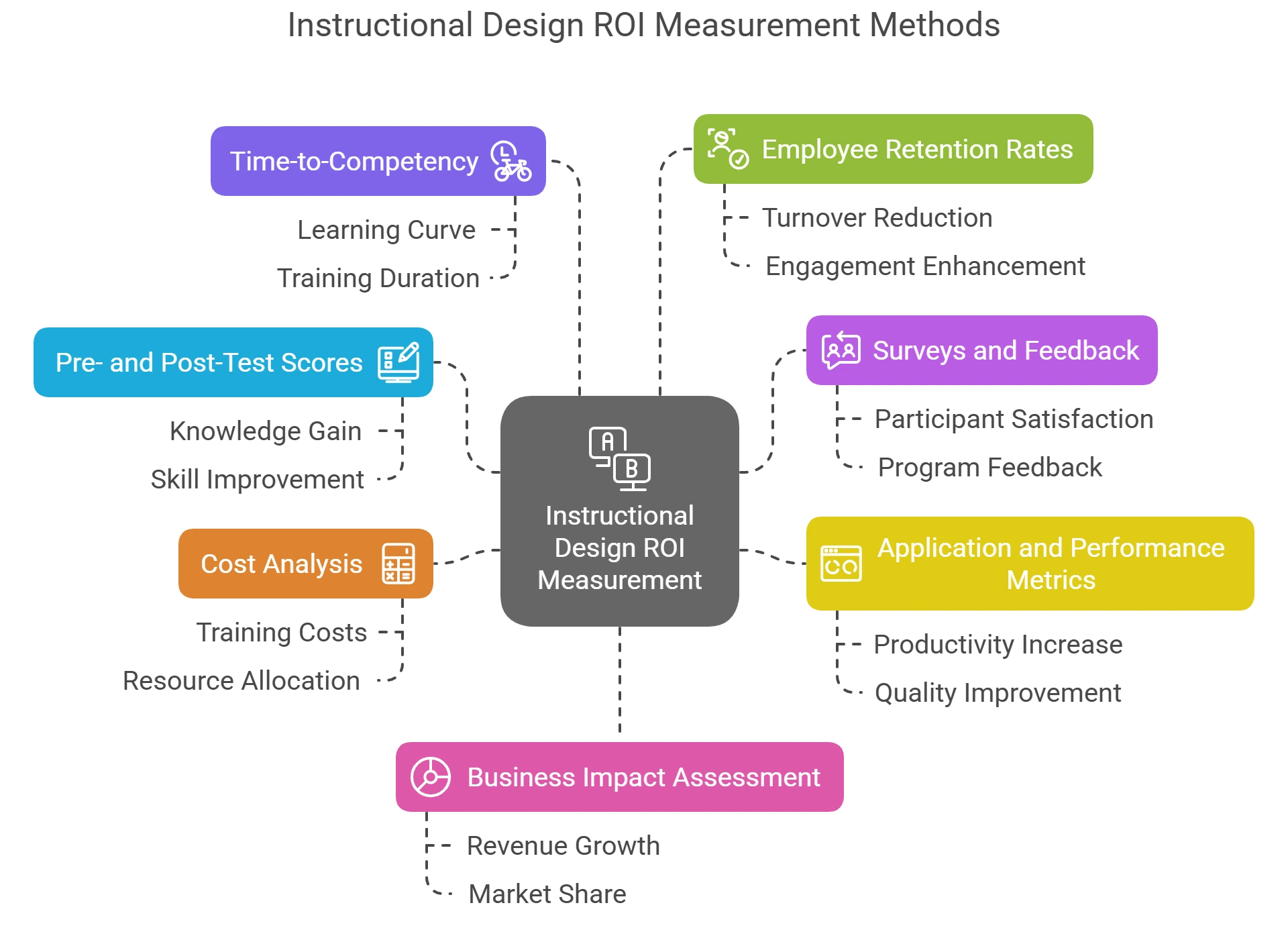
Some employees may increase their efficiency by 50 percent while others by 30 percent, yet others may not improve at all. Since it involves navigating a learning curve, changes in productivity will be slow initially as workers build familiarity and gradually increase as their comfort level and familiarity rise. Again, this makes estimating the ROI difficult. As a result, companies need to focus on specific, measurable points when designing training programs.
For instance, job completion rates during a defined period in highly repetitive roles can be a way out. On the whole, measuring ROI for training can be a challenging task. So, here are seven evaluation methods for instructional design you can consider while measuring your ROI in instructional design.
- Pre- and Post-Test Scores: Compare employees’ knowledge or skill levels before and after training. An improvement indicates the effectiveness of the program.
- Surveys and Feedback: Collect feedback from participants about the training’s relevance, clarity, and usefulness. Surveys before and after the training/e-learning session will help gauge the change in perceptions. Positive feedback suggests a higher ROI. Surveys, however, do not provide hard data on business outcomes or performance. Its value lies in capturing the engagement element of the training program. It is an important, albeit indirect, link to your ROI.
- Application and Performance Metrics: Evaluate how well employees apply what they’ve learned on the job. Increased proficiency directly correlates with a positive ROI. Identifying key performance indicators (KPI), which are specific metrics used to assess the effectiveness of a training program and aligned to the firm’s goals, is crucial. These include employee engagement, customer satisfaction, creativity, and productivity. They help by providing objective criteria to measure if the training program is achieving its objectives.
- Cost Analysis: Measuring the cost of training is crucial to determining the ROI of instructional design. The training costs include direct costs such as course material costs and trainer’s fees. It also includes indirect costs such as loss of employee time and productivity. Compare the costs of developing and implementing the training program to the benefits gained, such as increased productivity or reduced errors, thereby determining if the investment was worthwhile.
- Time-to-Competency: Measure the time it takes for employees to reach a desired level of proficiency after completing the training. A shorter duration implies a higher ROI, while a longer duration implies a lower ROI. This is because the quicker the agents become proficient, the more productive they become. Time to competency can be reduced by setting clear goals/outcomes, contextualizing new learning material through scenarios the employees may encounter in their roles, and differentiating content delivery modes (didactic and theoretical approach versus kinesthetic learning). User-centered training that is adaptable to individual training needs reduces time to competency.
- Employee Retention Rates: Determine if training programs increase retention rates. Investment in employee L&D has proved highly beneficial in meeting employees’ needs for progress and improvement. This implies reduced turnover, which can lead to substantial cost savings.
- Business Impact Assessment: Identify specific business outcomes influenced by the training, such as increased sales, improved customer satisfaction, or enhanced product quality.
Indicators that Your Instruction Needs Improvement
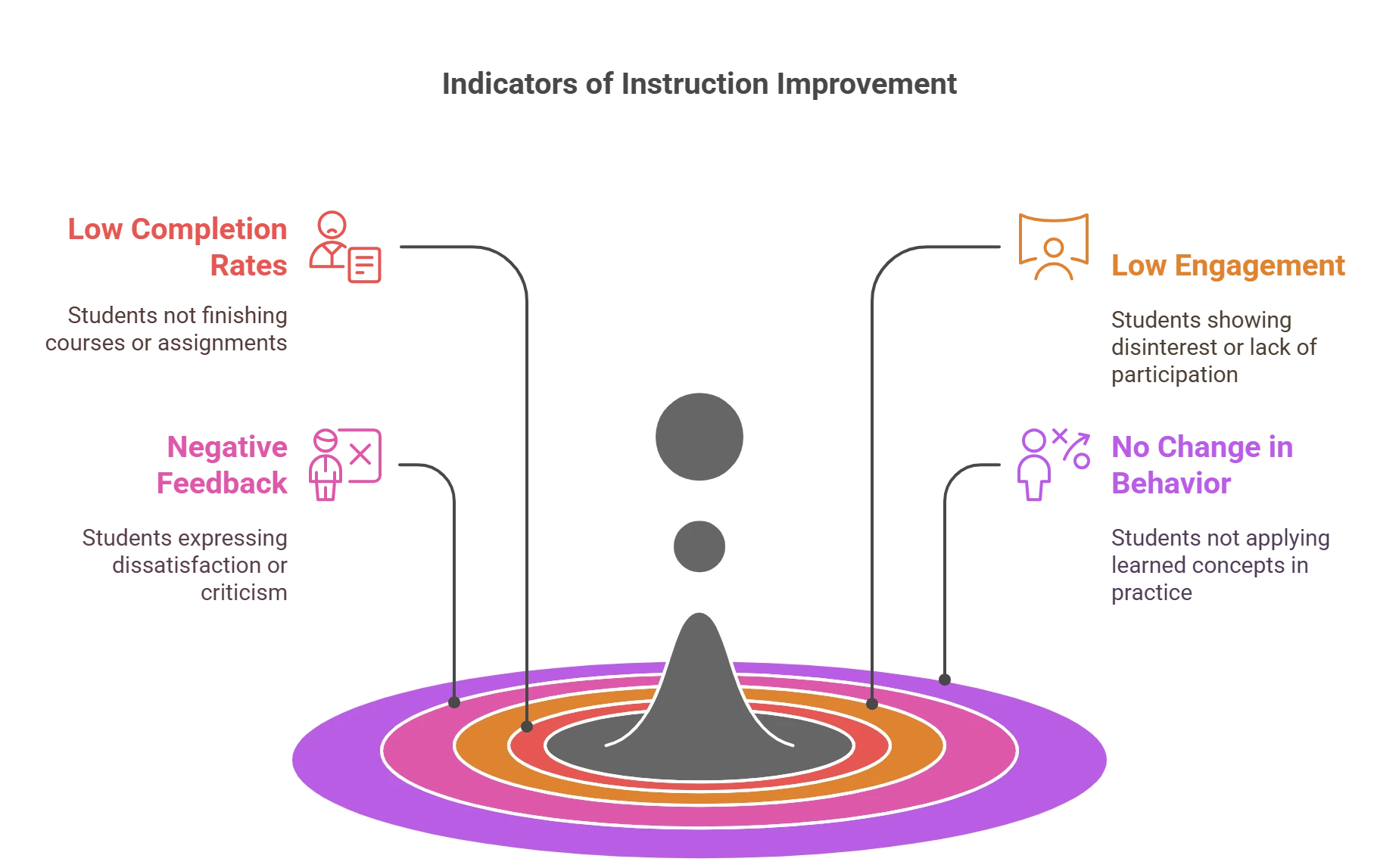
Assessing and evaluating learning outcomes is a great way to gauge whether your instructional design needs improvement. Here are key indicators of what it does:
1. Low Completion Rates
If learners are losing interest in the course and failing to complete it, it may indicate that you need to change your instruction or examine the reasons why they are dropping out. The content may be cumbersome and inaccessible, the exercises and assessments may be too challenging, or learners may find it difficult to relate to the course.
2. Low Engagement
Engagement rates can indicate whether your course is effective. If learners regularly ask questions, are participative, and engage in discussions with fellow learners, it shows they are engaged. If engagement drops during the course, this must also be factored in.
3. Negative Feedback
Reviews and feedback are key indicators of the effectiveness of your instruction. Negative reviews, particularly if there are several negative reviews, can cause concern.
4. No Change in Behavior
One of the ways of measuring learning effectiveness is to see if it results in a behavior change. You can assess learners’ behavior for changes to see if there is progress in their abilities.
Summing Up
Assessing and evaluating learning outcomes is integral to designing courses and curricula. It enables instructors to determine whether the course achieves the desired learning goals. Defining a plan for assessing outcomes helps ensure that the assessment is effective.
Program evaluation allows educators to make a data-led assessment of the course design. This can be done by considering student and faculty requirements, policies, procedures, and overall learning outcomes.
Hurix Digital offers eLearning services and higher education solutions. Our team applies instructional design models and theories in diverse domains to meet unique client needs. We help educational institutions create and deliver competency-based education, design and develop educational content, and offer business learning consulting and solutions.
Summarize with:

Senior Vice President – Business Development
at Hurix Digital, with over 25 years of experience in EdTech and workforce learning. He excels in business development, customer relationship management, and scaling digital learning solutions, driving global growth through innovative content, simulations, and AI‑driven training offerings
 Upcoming Masterclass | Build an Army of Brand Evangelists using Training & Development | November 20th, 8:30 AM PDT | 11:30 AM EDT | 10:00 PM IST
Upcoming Masterclass | Build an Army of Brand Evangelists using Training & Development | November 20th, 8:30 AM PDT | 11:30 AM EDT | 10:00 PM IST

